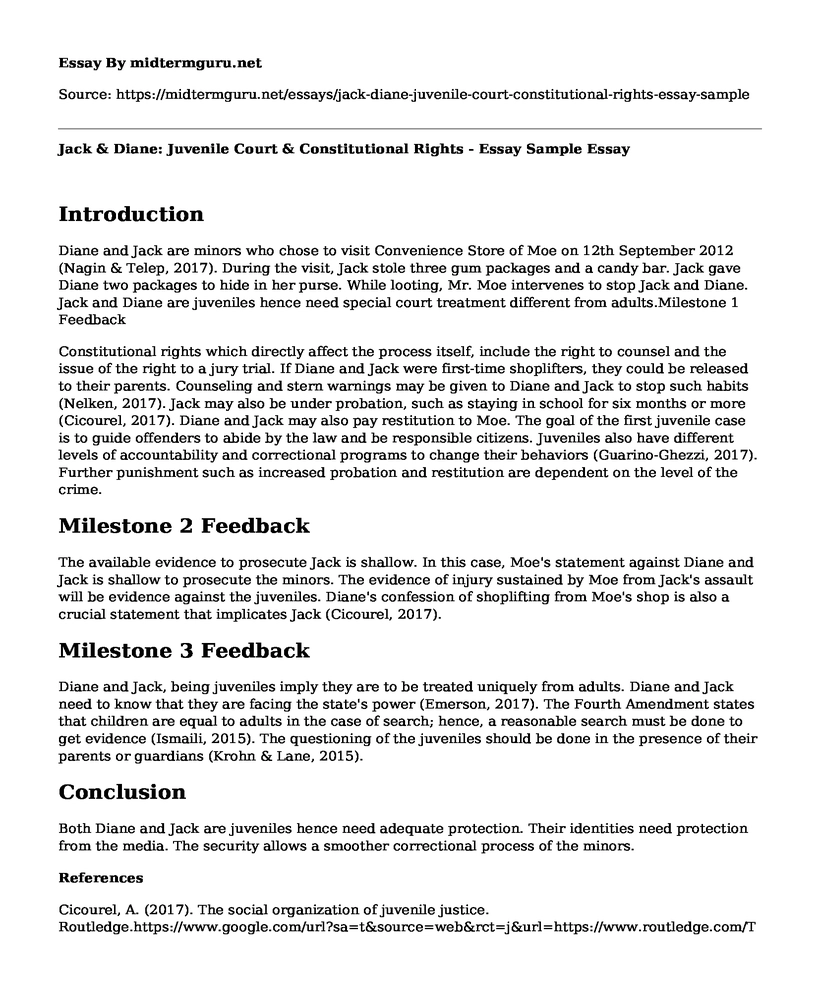Introduction
Diane and Jack are minors who chose to visit Convenience Store of Moe on 12th September 2012 (Nagin & Telep, 2017). During the visit, Jack stole three gum packages and a candy bar. Jack gave Diane two packages to hide in her purse. While looting, Mr. Moe intervenes to stop Jack and Diane. Jack and Diane are juveniles hence need special court treatment different from adults.Milestone 1 Feedback
Constitutional rights which directly affect the process itself, include the right to counsel and the issue of the right to a jury trial. If Diane and Jack were first-time shoplifters, they could be released to their parents. Counseling and stern warnings may be given to Diane and Jack to stop such habits (Nelken, 2017). Jack may also be under probation, such as staying in school for six months or more (Cicourel, 2017). Diane and Jack may also pay restitution to Moe. The goal of the first juvenile case is to guide offenders to abide by the law and be responsible citizens. Juveniles also have different levels of accountability and correctional programs to change their behaviors (Guarino-Ghezzi, 2017). Further punishment such as increased probation and restitution are dependent on the level of the crime.
Milestone 2 Feedback
The available evidence to prosecute Jack is shallow. In this case, Moe's statement against Diane and Jack is shallow to prosecute the minors. The evidence of injury sustained by Moe from Jack's assault will be evidence against the juveniles. Diane's confession of shoplifting from Moe's shop is also a crucial statement that implicates Jack (Cicourel, 2017).
Milestone 3 Feedback
Diane and Jack, being juveniles imply they are to be treated uniquely from adults. Diane and Jack need to know that they are facing the state's power (Emerson, 2017). The Fourth Amendment states that children are equal to adults in the case of search; hence, a reasonable search must be done to get evidence (Ismaili, 2015). The questioning of the juveniles should be done in the presence of their parents or guardians (Krohn & Lane, 2015).
Conclusion
Both Diane and Jack are juveniles hence need adequate protection. Their identities need protection from the media. The security allows a smoother correctional process of the minors.
References
Cicourel, A. (2017). The social organization of juvenile justice. Routledge.https://www.google.com/url?sa=t&source=web&rct=j&url=https://www.routledge.com/The-Social-Organization-of-Juvenile-Justice-1st-Edition/Cicourel/p/book/9781315134994&ved=2ahUKEwis4L74qYnkAhXyxoUKHWxWA4gQFjAAegQIBRAB&usg=AOvVaw37ROqU_eHyVw9Qa5c3TfFr
Emerson, R. M. (2017). Judging delinquents: Context and process in juvenile court. Routledge.https://www.google.com/url?sa=t&source=web&rct=j&url=https://www.taylorfrancis.com/books/9780203787854&ved=2ahUKEwiG6bedqonkAhWhzoUKHXdHCzwQFjABegQIBBAB&usg=AOvVaw3ckn-ehhEA2GT9UEQfMUEc
Guarino-Ghezzi, S. (2017). Balancing juvenile justice. Routledge.https://www.google.com/url?sa=t&source=web&rct=j&url=https://www.routledge.com/Balancing-Juvenile-Justice-2nd-Edition/Guarino-Ghezzi/p/book/9781351314923&ved=2ahUKEwiE6Iy2qonkAhUOYxoKHaULBqIQFjAAegQIAxAB&usg=AOvVaw3_j0xpz7U28AAyxgc7HzuG
Ismaili, K. (2015). US criminal justice policy: A contemporary reader. Jones & Bartlett Publishers.https://www.google.com/url?sa=t&source=web&rct=j&url=https://www.amazon.com/U-S-Criminal-Justice-Policy-Contemporary/dp/0763741299&ved=2ahUKEwjM-rCsqYnkAhVH1hoKHSC0B40QFjAAegQICRAC&usg=AOvVaw2LcehOGZ7sSw1CHrUqGV7G
Krohn, M. D., & Lane, J. (Eds.). (2015). The handbook of juvenile delinquency and juvenile justice. John Wiley & Sons.https://www.google.com/url?sa=t&source=web&rct=j&url=https://onlinelibrary.wiley.com/doi/pdf/10.1002/9781118513217&ved=2ahUKEwib1tLBqYnkAhVDxhoKHW7yAaoQFjAAegQIBxAC&usg=AOvVaw0-DNEMb2o9tx6aMrpRdiwY
Nagin, D. S., & Telep, C. W. (2017). Procedural justice and legal compliance. Annual review of law and social science, 13, 5-28.https://www.google.com/url?sa=t&source=web&rct=j&url=https://www.annualreviews.org/doi/10.1146/annurev-lawsocsci-121416-011426&ved=2ahUKEwibx43oqonkAhXGx4UKHX0iDkwQFjABegQICRAB&usg=AOvVaw0xj0X6-O6znsvGmJ0YHw-2
Nelken, D. (2017). Comparing legal cultures. Routledge.https://www.google.com/url?sa=t&source=web&rct=j&url=https://www.amazon.com/Comparing-Legal-Cultures-Socio-Legal-Studies/dp/1855218984&ved=2ahUKEwid0YrOqonkAhVP1BoKHVWZBI0QFjACegQIAhAB&usg=AOvVaw2Yo3a5cw4UityFzJUNaPh6
Cite this page
Jack & Diane: Juvenile Court & Constitutional Rights - Essay Sample. (2023, Feb 05). Retrieved from https://midtermguru.com/essays/jack-diane-juvenile-court-constitutional-rights-essay-sample
If you are the original author of this essay and no longer wish to have it published on the midtermguru.com website, please click below to request its removal:
- Essay on Sleepy Lagoon Murder Case
- Actions That Limit an Individual to Take Part in a Crime
- Essay Sample on Gender-Specific Programs in Juvenile Justice System
- New York Leaders on LGBT Rights - Paper Example
- Research Paper on Effects of Solitary Confinement
- Importance of Funding a Rehabilitative Program for Offenders in NC - Essay Sample
- 16 Charged With Killing 19-Year Old Over Sexual Harassment - Essay Sample







